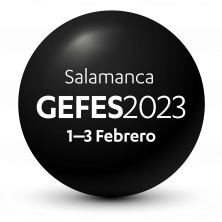
Conference booklet. Book of abstracts
Conference Program in a nutshell
You can now download the short brief Conference Program or the detailed GEFES2023 Program. Keynote talks will last 45 minutes while invited and oral contributions 20 including, all of them, time for questions and discussion. There will be two poster sessions on Wednesday and another two on Thursday during the main coffee breaks.
List of Keynote speakers:
Rebeca Ribeiro (C2N Paris-Saclay and CNRS) – Non-identical moiré twins in bilayer graphene
Jairo Sinova (Inspire Group, University of Mainz) – The emergence of research landscape of altermagnetism
Olivier Dauchot (ESPCI CNRS – Paris) – When active matter turns solid : from collective motion to collective actuation
Alejandro Manjavacas (Instituto Daza de Valdés CSIC) – Lattice resonances: a collective response of periodic arrays of nanostructures
Irene Calvo (INMA – CSIC , University of Zaragoza) – Synchrotron X-ray Coherence to Probe the Complexity of realistic interfaces at the Nanoscale
Natalia Ares (Oxford University) – Quantum devices for thermodynamics at the nanoscale
List of confirmed Invited speakers:
Elena Pinilla (Valencia Nanophotonics Technology Center, Universitat Politécnica de València) – Optical bistability based on the integration of a molecular nanomaterial in silicon photonics
Javier del Valle (Department of Quantum Matter Physics, University of Geneva) – Fundamentals and applications of the voltage-triggered insulator to metal transition
Sandra Ruiz Gómez (Max Planck Institute for Chemical Physics of Solids, Dresden) – Direct x-ray detection of the Spin Hall Effect
Daniel Gosálbez (Universidad de Alicante) – Diversity of radial spin textures in chiral materials
Fernando de Juan (DIPC) – Magnetic Kondo lattices in two dimensional metallic dichalcogenides
Ana Isabel Borrás Martos (ICMSE CSIC) – Nanogeneratos and self-powered sensors enable by plasma and vacuum processing of multifunctional thin films and 3D nanoarchitectures
José Hugo García Aguilar (ICN2) – Electronic control of spin currents in low-symmetry transition metal dichalcogenides
Rui E. F. Silva (ICMM – CSIC) – Strong field phenomena in solids
Marco Gobbi (Nanogune) – Non-reciprobal charge transport in chiral Tellurium nanowires
Sara Lafuerza Bielsa (INMA – University of Zaragoza) – Investigating new electrocaloric oxides for sustainable and efficient refrigeration applications
Beatriz Martín García (Nanogune) – Layered hybrid metal-halide perovskites under strain: insights from photoluminescence and micro-Raman spectroscopy
Lourdes Marcano (Universidad de Oviedo) – Quantifying the magnetic anisotropy of 50 nm-magnetic nanoparticles embedded in biological entitities
Pablo Ares (Universidad Autónoma de Madrid) – Piezoelectrictiy and ferroelectricity in hexagonal boron nitride
Paloma Arroyo Huidobro (University of Lisbon) – Temporal and spatio-temporal metamaterials
Laura Rodríguez Arriaga (Universidad Autónoma de Madrid) – Rotating vesicles to mimic cell motion
Juan Antonio Delgado Notario (University of Salamanca) – Graphene field effect transistors for THz technology and applications
Edwin Herrera (Universidad Autónoma de Madrid) – Visualizing waves and quantum well states at the surface of the heavy fermion URu2Si2
